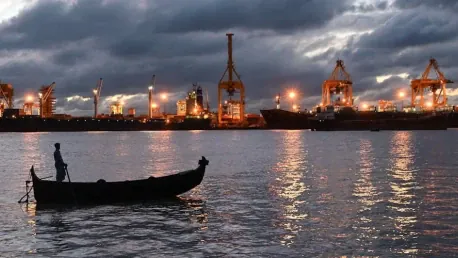Over the past six years, the maritime industry has witnessed a significant surge in orders for dual-fuel ships, marking a notable shift towards decarbonization and future-proofing fleets. According to data from Veson Nautical, the proportion of container vessels equipped with dual-fuel engines has skyrocketed from a mere 4% in 2018 to an impressive 65% in 2024. This trend underscores the container shipping sector’s growing commitment to adopting sustainable and flexible energy solutions in response to global environmental concerns.
The Rise of Dual-Fuel Engine Technology
Adoption of Sustainable and Flexible Energy Solutions
Dual-fuel engines provide the notable advantage of running on both traditional marine fuels, such as heavy fuel oil, and less carbon-intensive alternatives like liquefied natural gas (LNG). While LNG vessels have been utilizing this technology for some time, other maritime sectors, particularly container shipping, are now rapidly embracing it. This technological evolution is viewed as a pivotal component in the global maritime industry’s journey toward an energy transition that will contribute to significantly lower emissions and enhance operational efficiency.
The adoption of dual-fuel technology is not merely a fleeting trend but a strategic response to mounting regulatory pressures and the increasing demand for greener shipping solutions. With international organizations like the International Maritime Organization (IMO) setting stringent carbon reduction targets, shipping companies are increasingly motivated to retrofit their fleets with dual-fuel engines. This shift is more crucial than ever, given the global commitment to achieving net-zero emissions by mid-century.
Container Shipping Sector’s Transformation
Veson Nautical data reveals that new orders for container vessels have surged by over 50% in 2024 compared to the previous year, with a remarkable 254 contracts placed. This increase is corroborated by the shipping association BIMCO, which reports that shipyards have achieved a new annual record, delivering 410 containerships. This heightened activity demonstrates the container shipping sector’s response to the escalating need for sustainable transport solutions and its pivotal role in leading the charge toward decarbonization.
However, despite the sweeping advancements in the container shipping industry, notable gaps remain in the order book for other sectors like ferries, offshore vessels, and smaller bulk carriers. The primary challenges faced by these smaller vessels include higher costs, space constraints, and limited operational range, making the adoption of conventional dual-fuel engine technology less feasible. Addressing these challenges requires innovative solutions tailored to the unique operational needs of these smaller ships.
The Expanding LNG Fleet
Growth of the Global LNG Infrastructure
The LNG fleet’s trajectory continues to soar, with a robust global infrastructure supporting this growth for decades. Data from VesselsValue shows that the live LNG fleet’s capacity has surged dramatically by approximately 142% over the past decade, increasing from 47.1 million cubic meters in 2014 to an astounding 113.9 million cubic meters in 2024. This expansion is fueled further by a steady increase in cargo miles, which have doubled from 230 billion cubic meters per nautical mile to 504 billion cubic meters per nautical mile since 2014. This growth signifies a rising reliance on LNG carriers in the global trade landscape.
With LNG supply anticipated to rise by 57 million tonnes per annum by 2026, the market for LNG carriers is poised for further expansion. The maritime industry’s escalating demand for dual-fuel engines, capable of burning LNG, is projected to drive this growth, reinforcing LNG’s position as a critical component of the sector’s energy mix. This expanding infrastructure underlines the industry’s readiness to support wider adoption of LNG-powered ships and highlights the ongoing investment in enhancing LNG bunkering facilities at ports worldwide.
Industry Confidence and Market Dynamics
Olivia Watkins, Associate Director of Valuations and Analytics at Veson Nautical, emphasized that the significant increase in the global LNG fleet reflects owners’ confidence in this market and their focus on replacing older, less-efficient vessels. This strategic replacement signals a broader industry trend towards optimizing fleet efficiency and reducing greenhouse gas emissions. As older vessels are phased out in favor of newer, more technologically advanced dual-fuel models, the maritime industry’s commitment to sustainability becomes even more evident.
Furthermore, the transition to dual-fuel engines aligns with broader market dynamics, including fluctuations in fuel prices and the push for energy security. LNG offers a relatively more stable pricing environment compared to traditional marine fuels, providing shipowners with a cost-effective and environmentally friendly alternative. This economic incentive, coupled with regulatory compliance and the desire to mitigate the environmental impact of shipping, drives the continued proliferation of dual-fuel technology throughout the maritime industry.
Challenges for Smaller Vessels
Navigating Higher Costs and Space Constraints
Despite the promising advancements in dual-fuel technology, certain segments of the maritime industry, such as ferries, offshore vessels, and smaller bulk carriers, face significant adoption challenges. One of the primary hurdles for these smaller vessels is the higher cost associated with retrofitting or building new ships equipped with dual-fuel engines. These costs can be prohibitive, especially for operators with limited financial resources, making it difficult to justify the substantial investment needed to transition to more sustainable fuel options.
Moreover, space constraints on smaller vessels present another substantial challenge. Dual-fuel engines and the necessary storage tanks for LNG require additional space that smaller ships may find challenging to accommodate without compromising cargo capacity or operational efficiency. This spatial limitation necessitates innovative engineering solutions that can integrate dual-fuel technology without sacrificing the inherent advantages of smaller vessels, such as maneuverability and speed.
Exploring Creative Solutions
Addressing the unique requirements of smaller vessels calls for creative and tailored solutions that make dual-fuel technology viable for this segment of the maritime industry. One approach involves developing more compact and efficient LNG storage systems that can fit within the space constraints of smaller ships. Advances in cryogenic technology and modular LNG tank systems show promise in addressing these spatial challenges, enabling smaller vessels to adopt dual-fuel engines without significant sacrifices in cargo capacity or operational performance.
Additionally, exploring alternative sustainable fuels, such as bio-LNG or synthetic LNG, could offer smaller vessels a more practical route to decarbonization. These fuels can be produced from renewable sources, reducing the overall carbon footprint of maritime operations. By investing in research and development of these alternative fuels, the industry can provide a broader range of options for smaller vessel operators seeking to transition to more sustainable energy sources.
Conclusion
Over the past six years, the maritime industry has seen a tremendous increase in orders for dual-fuel ships, indicating a concerted effort towards decarbonization and future-proofing fleets. Data from Veson Nautical reveals that the share of container vessels with dual-fuel engines has jumped substantially from just 4% in 2018 to a remarkable 65% by 2024. This significant rise highlights the container shipping sector’s growing dedication to embracing sustainable and flexible energy solutions, driven by mounting global environmental concerns.
The shift towards dual-fuel ships reflects the industry’s response to the urgent call for reducing carbon emissions and addressing climate change. These vessels are designed to run on both conventional fuel and cleaner alternatives like LNG, offering versatility and a step towards lowering the industry’s carbon footprint. As international regulations and environmental standards become stricter, the adoption of dual-fuel technology not only aims to meet compliance but also positions these ships as more adaptable and efficient for future energy transitions.









